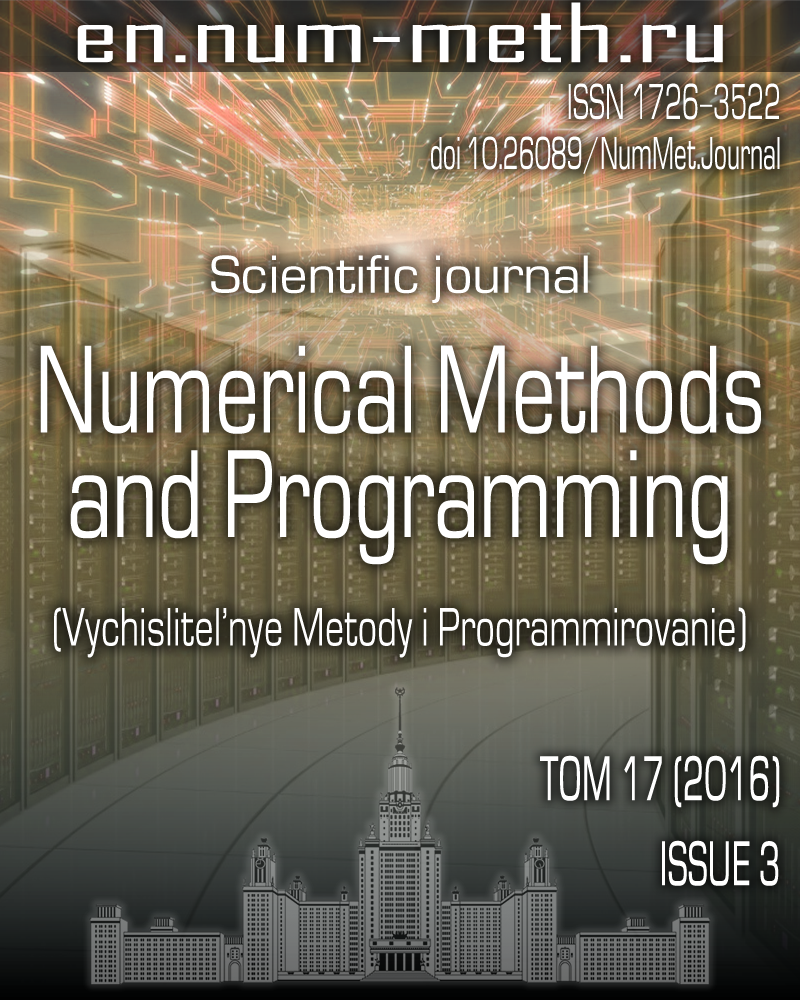Some control and inverse problems for linear parabolic equations
DOI:
https://doi.org/10.26089/NumMet.v17r326Keywords:
parabolic equations, control problems, duality principle, density property, controllability, inverse problems, adjoint problems, final overdetermination, uniquenessAbstract
Properties of solutions of control and inverse problems for one-dimensional parabolic equations with coefficients dependent on (x,t) are studied. The proposed approach based on the duality principle allows one to generalize the known Lions’ result on the density properties of averaged observations in control problems with a control function given in the initial conditions. It is shown that the significance of these density properties is not restricted to the control problems. Such properties are used to study inverse parabolic problems, in particular, to study the uniqueness conditions of their solutions.
References
- O. A. Ladyzhenskaya, V. A. Solonnikov, and N. N. Ural’tseva, Linear and Quasilinear Equations of Parabolic Type (Nauka, Moscow, 1967; SIAM, Providence, 1968).
- R. Lattés and J.-L. Lions, The Method of Quasi-Reversibility: Application to Partial Differential Equations (Elsevier, New York, 1969; Mir, Moscow, 1970).
- J.-L. Lions, Optimal Control of Systems Described by Partial Differential Equations (Springer, Heidelberg, 1971; Mir, Moscow, 1972).
- M. Lees and M. H. Protter, “Unique Continuation for Parabolic Differential Equations and Inequalities,” Duke Math. J. 28 (3), 369-382 (1961).
- A. Friedman, Partial Differential Equations of Parabolic Type (Prentice Hall, Englewood Cliffs, 1964; Mir, Moscow, 1968).
- M. V. Klibanov, “On a Class of Inverse Problems for Nonlinear Parabolic Equations,” Dokl. Akad. Nauk SSSR 280 (3), 533-536 (1985) [Sov. Math. Dokl. 31, 104-107 (1985)].
- A. I. Prilepko and V. V. Solov’ev, “Solvability Theorems and Rothe Method in Inverse Problems for Equations of Parabolic Type,” Differ. Uravn. 23 (11), 1971-1980 (1987) [Differ. Equ. 23 (11), 1341-1349 (1987)].
- V. Isakov, “Inverse Parabolic Problems with the Final Overdetermination,” Comm. Pure Appl. Math. 44 (2), 185-209 (1991).
- A. B. Kostin, “The Inverse Problem of Recovering the Source in a Parabolic Equation under a Condition of Nonlocal Observation,” Mat. Sb. 204 (10), 3-46 (2013) [Sb. Math. 204 (10), 1391-1434 (2013)].
- A. B. Kostin, “Counterexamples in Inverse Problems for Parabolic, Elliptic, and Hyperbolic Equations,” Zh. Vychisl. Mat. Mat. Fiz. 54 (5), 779-792 (2014) [Comput. Math. Math. Phys. 54 (5), 797-810 (2014)].
- W. Rundell, “Determination of an Unknown Non-Homogeneous Term in a Linear Partial Differential Equation from Overspecified Boundary Data,” Appl. Anal. 10, 231-242 (1980).
- A. I. Prilepko and I. V. Tikhonov, “A Positive Solution Principle for a Linear Inverse Problem and Applications to a Coefficient Problem of Heat Conductivity,” Dokl. Akad. Nauk 364 (1), 21-23 (1999) [Dokl. Math. 59 (1), 14-16 (1999)].
- A. I. Prilepko, D. G. Orlovsky, and I. A. Vasin, Methods for Solving Inverse Problems in Mathematical Physics (Marcel Dekker, New York, 2000).
- A. M. Denisov, Introduction to the Theory of Inverse Problems (Mosk. Gos. Univ., Moscow, 1994) [in Russian].
- V. L. Kamynin, “On the Inverse Problem of Determining the Right-Hand Side of a Parabolic Equation under an Integral Overdetermination Condition,” Mat. Zametki 77 (4), 522-534 (2005) [Math. Notes 77 (4), 482-493 (2005)].
- A. I. Kozhanov and R. R. Safiullova, “Linear Inverse Problems for Parabolic and Hyperbolic Equations,” J. Inv. Ill-Posed Probl. 18 (1), 1-24 (2010).
- H. Egger, H. W. Engl, and M. V. Klibanov, “Global Uniqueness and Hölder Stability for Recovering a Nonlinear Source Term in a Parabolic Equation,” Inv. Probl. 21 (1), 271-290 (2005).
- V. Isakov, “On Uniqueness in the Inverse Conductivity Problem with Local Data,” Inverse Probl. Imaging 1 (1), 95-105 (2007).
- Y. B. Wang, J. Cheng, J. Nakagawa, and M. Yamamoto, “A Numerical Method for Solving the Inverse Heat Conduction Problem without Initial Value,” Inverse Probl. Sci. Eng. 18 (5), 655-671 (2010).
- M. Slodička, D. Lesnic, and T. T. M. Onyango, “Determination of a Time-Dependent Heat Transfer Coefficient in a Nonlinear Inverse Heat Conduction Problem,” Inverse Probl. Sci. Eng. 18 (1), 65-81 (2010).
- N. N. Salva and D. A. Tarzia, “Simultaneous Determination of Unknown Coefficients through a Phase-Change Process with Temperature-Dependent Thermal Conductivity,” JP J. Heat Mass Transfer 5 (1), 11-39 (2011).
- S. G. Pyatkov and B. N. Tsybikov, “On Some Classes of Inverse Problems for Parabolic and Elliptic Equations,” J. Evol. Equ. 11 (1), 155-186 (2011).
- A. Erdem, D. Lesnic, and A. Hasanov, “Identification of a Spacewise Dependent Heat Source,” Appl. Math. Model. 37 (24), 10231-10244 (2013).
- J. Wen, M. Yamamoto, and T. Wei, “Simultaneous Determination of a Time-Dependent Heat Source and the Initial Temperature in an Inverse Heat Conduction Problem,” Inverse Probl. Sci. Eng. 21 (3), 485-499 (2013).
- D. N. Háo, P. X. Thanh, D. Lesnic, and M. Ivanchov, “Determination of a Source in the Heat Equation from Integral Observations,” J. Comput. Appl. Math. 264, 82-98 (2014).
- S. F. Gilyazov and N. L. Gol’dman, Regularization of Ill-Posed Problems by Iteration Methods (Kluwer, Dordrecht, 2000).
Downloads
Published
How to Cite
Issue
Section
License
Copyright (c) 2016 Вычислительные методы и программирование

This work is licensed under a Creative Commons Attribution 4.0 International License.

